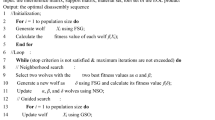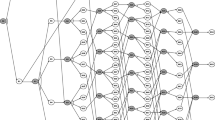Abstract
In addition to garbage sorting and resource recycling, green design should be a fundamental method for solving environmental problems, and design for disassembly is an important foundation of green design. This study focuses on providing quantitative assessment methods for designers’ reference. This study proposes interactive genetic algorithms to solve the problem of disassembly sequence planning. First, the disassembly factor is measured by the fuzzy scoring procedure method, and then the genetic algorithm is used to select the optimal sequence. With the penalty value provided from the process, a reference is provided for the revised design. Finally, examples are discussed to demonstrate that the proposed approach is a feasible method.
















Similar content being viewed by others
References
Otto, K., & Wood, K. (2001). Product design-technical in reverse engineering and new product development. Upper Saddle River: Prentice Hall.
Chiu, M. C., & Chu, C. H. (2012). Review of sustainable product design from life cycle perspectives. International Journal of Precision Engineering and Manufacturing,13(7), 1259–1272.
Boothroyd, G., & Dewhurst, P. (1983). Design for assembly: A designer’s handbook. Amherst: University of Massachusetts.
Huisman, J., Boks, C. B., & Stevels, A. L. N. (2003). Quotes for environmentally weighted recyclability (QWERTY): Concept of describing product recyclability in terms of environmental value. International Journal of Production Research,41(16), 3649–3665.
Tseng, M. M., & Jiao, J. (1996). Design for mass customization. CIRP Annals-Manufacturing Technology,45(1), 153–156.
Sakundarini, N., Taha, Z., Ghazilla, R. A. R., & Abdul-Rashid, S. H. (2015). A methodology for optimizing modular design considering product end of life strategies. International Journal of Precision Engineering and Manufacturing,16(11), 2359–2367.
Tseng, H. E., Chang, C. C., & Li, J. D. (2008). Modular design to support green life-cycle engineering. Expert Systems with Applications,34(4), 2524–2537.
Fikset, J., & Wapman, R. (1996). Design for environment: Creating eco-efficient products and processes. New York: McGraw-Hill.
Arnette, A. N., Brewer, B. L., & Choal, T. (2014). Design for sustainability (DFS): The intersection of supply chain and environment. Journal of Cleaner Production,83, 374–390.
Srinivasan, H., Figueroa, R., & Gadh, R. (1999). Selective disassembly for virtual prototyping as applied to de-manufacturing. Robotics and Computer-Integrated Manufacturing,15, 231–245.
Kroll, E., Beardsley, B., & Parulian, A. (1996). A methodology to evaluate ease of disassembly for product recycling. IIE Transaction,28(10), 837–845.
Desai, A., & Mital, A. (2003). Evaluation of disassemblability to enable design for disassembly in mass production. International Journal of Industrial Ergonomics,32(4), 265–281.
Cappelli, F., Delogu, M., Pierini, M., & Schiavone, F. (2007). Design for disassembly: A methodology for identifying the optimal disassembly sequence. Journal of Engineering Design,18(6), 563–575.
Favi, C., Germani, M., Luzi, A., Mandolini, M., & Marconi, M. (2017). A design for EoL approach and metrics to favour closed-loop scenarios for products. International Journal of Sustainable Engineering,10(3), 136–148.
Ghandi, S., & Msaehian, E. (2015). Review and taxonomies of assembly and disassembly path planning problems and approaches. Computer-Aided Design,67–68, 58–86.
Kongar, E., & Gupta, S. M. (2006). Disassembly sequencing using genetic algorithm. The International Journal of Advanced Manufacturing Technology,30(5–6), 497–506.
Giudice, F., & Fargione, G. (2007). Disassembly planning of mechanical systems for service and recovery: A genetic algorithms based approach. Journal of Intelligent Manufacturing,18(3), 313–329.
Hui, W., Dong, X., & Guanghong, D. (2008). A genetic algorithm for product disassembly sequence planning. Neurocomputing,71(13–15), 2720–2726.
Go, T. F., Wahab, D. A., Ab Rahman, M. N., Ramli, R., & Hussain, A. (2012). Genetically optimized disassembly sequence for automotive component reuse. Expert System with Applications,39(5), 5409–5417.
Kheder, M., Trigui, M., & Aifaoui, N. (2015). Disassembly sequence planning based on a genetic algorithm. Proceedings of the Institution of Mechanical Engineers, Part C Journal of mechanical of Engineering Science,3, 1–10.
Tseng, H. E., Chang, C. C., Lee, S. C., & Huang, Y. M. (2018). A block-based genetic algorithm for disassembly sequence planning. Expert System with Applications,96, 492–505.
Takagi, H. (2001). Interactive evolutionary computation: Fusion of the capabilities of EC optimization and human evaluation. Proceedings of the IEEE,89(9), 1275–1296.
Yan, S., Wang, W., & Liu, X. (2010). An improved evaluation method for interactive genetic algorithms and its application in product design. In IEEE fifth international conference on bio-inspired computing: Theories and applications (BIC-TA) (pp. 23–26).
Babbar-Sebens, M., & Minsker, B. S. (2012). Interactive genetic algorithm with mixed initiative interaction for multi-criteria ground water monitoring design. Applied Soft Computing,12(1), 182–195.
Dou, R., Zong, C., & Nan, G. (2016). Multi-stage interactive genetic algorithm for collaborative product customization. Knowledge-Based Systems,92, 43–54.
Bevillacqua, M., & Petroni, A. (2002). From traditional purchasing to supplier management: A fuzzy logic-based approach to supplier selection. International Journal of Logistics: Research and Applications,3(3), 235–255.
Li, J. R., Khoo, L. P., & Tor, S. B. (2005). An object-oriented intelligent disassembly sequence planner for maintenance. Computers in Industry,56, 699–718.
Vanegas, P., Peeters, J. R., Cattrysse, D., Tecchio, P., Ardente, F., Mathieux, F., et al. (2018). Ease of disassembly of products to support circular economy strategies. Resources Conservation & Recycling,135, 323–334.
Dorigo, M., & Gambardella, L. M. (1997). Ant colony system: A cooperative leaning approach to the traveling salesman problem. IEEE Transactions in Evolutionary Computation,1(1), 53–66.
Acknowledgements
This research was supported by the Ministry of Science and Technology of the Republic of China under Grant No. MOST 106-2410-H-167-007.
Author information
Authors and Affiliations
Corresponding author
Additional information
Publisher's Note
Springer Nature remains neutral with regard to jurisdictional claims in published maps and institutional affiliations.
Rights and permissions
About this article
Cite this article
Lee, SC., Tseng, HE., Chang, CC. et al. Applying Interactive Genetic Algorithms to Disassembly Sequence Planning. Int. J. Precis. Eng. Manuf. 21, 663–679 (2020). https://doi.org/10.1007/s12541-019-00276-w
Received:
Revised:
Accepted:
Published:
Issue Date:
DOI: https://doi.org/10.1007/s12541-019-00276-w




